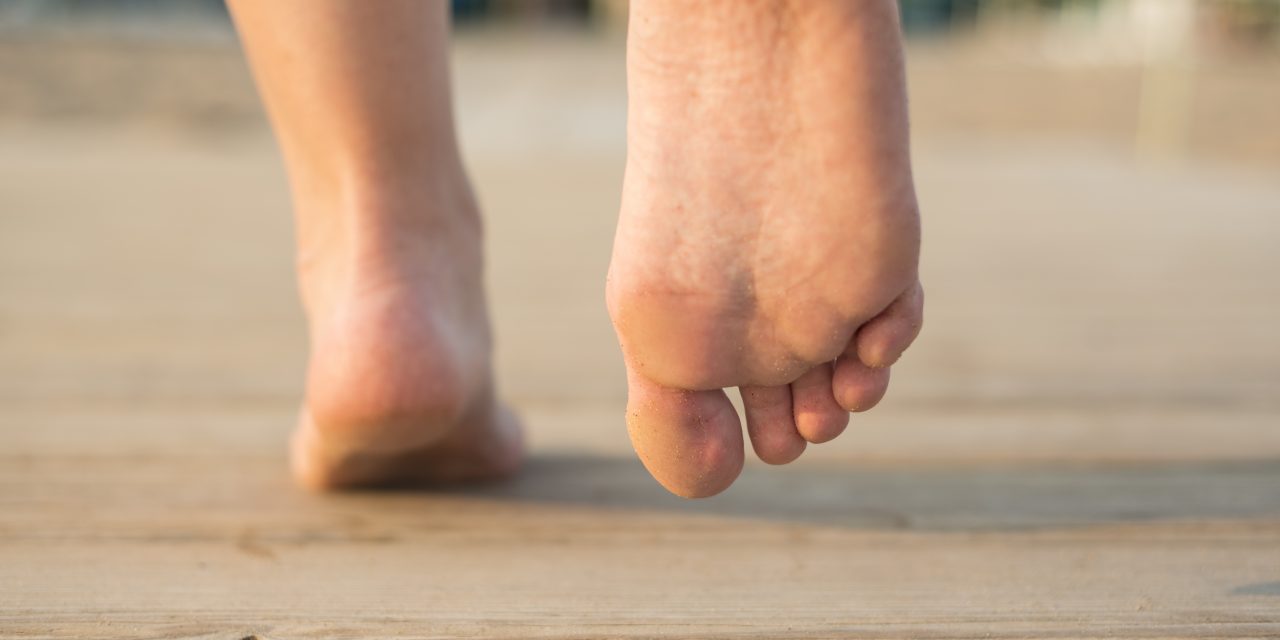
Progressive Arch Collapse

Painful Progressive Arch Collapse
This month we focus on the posterior tibialis tendon that, when healthy, serves as the key support for the foot, but when dysfunctional, it may lead to a plethora of problems related to the progressive arch collapse. Posterior tibial tendon dysfunction (PTTD) is the most common cause of adult-acquired flat foot. 1 Symptoms begin with pain and may progress to degeneration and deformity if left untreated. 1,3 Early recognition and management can lead to significantly improved outcomes. 1
Anatomy
The deep compartment of the leg consists of three muscles: the posterior tibialis (PT), flexor digitorium longus (FDL), and flexor hallucis longus (FHL). The posterior tibialis is the deepest and largest muscle of the trio, typically comprising almost 60% of the cross-sectional area of the entire deep compartment. 4-7 The posterior tibialis originates on the interosseous membrane and the posterior surfaces of the tibia and fibula. 4 The muscle’s tendon begins several centimeters above the ankle then courses through the deep posterior compartment of the leg behind the medial malleolus, before turning toward its main attachment on the navicular tuberosity. 4 Ancillary attachments include the second and third cuneiform, cuboid, bases of the second, third, & fourth metatarsals, and sustentaculum tali of the calcaneous. 4,8-10
Actions of the posterior tibialis muscle include inversion and plantar flexion of the foot. Because of its size and moment arm, the posterior tibialis is the primary elevator and dynamic stabilizer of the medial longitudinal arch of the foot. 5,11-15 During the normal gait cycle, the posterior tibialis lifts the medial longitudinal arch, thereby interlocking the tarsals (calcaneous, cuboid, talus, and navicular) into a rigid lever for propulsion. 12,17 The role of the posterior tibialis is most significant during push off. 18,19
Early literature suggested that up to 50% of PTTD cases arose from trauma. 20,21 More recent literature suggests that the majority of cases begin from repeated microtrauma. 22 Repetitive stressors initiate a cascade of dysfunction that begins with “normal” inflammation but regresses to “failed healing,” fibrosis, and tendon degeneration. Degeneration affects the gliding resistance of the tendon and progressively diminishes the tendon’s ability to support the foot. 22 As the tendon becomes less effective, the longitudinal arch of the foot is allowed to collapse; thereby, increasing strain on the posterior tibialis. 22,25,26 The most common site for injury is a zone of relative hypovasulcarity directly posterior to the medial malleolus. 22,27,28
Stages
The continuum of PTTD progresses through the following stages: 29
ITenosynovitis without deformity
IIAFlat foot deformity
IIBFlat foot deformity with excessive forefoot abduction
IIIRigid forefoot abduction and hindfoot valgus
IVDeltoid ligament compromise
Like most cumulative trauma disorders, the etiology of posterior tibial tendon dysfunction is multi-factorial. Problems typically arise when repetitive strain exceeds the tendon’s threshold for injury. Extrinsic factors that contribute to the development of posterior tibial tendinopathy include training errors, particularly those related to intensity, duration, and/or training on excessively hard surfaces. 30 In addition to the obvious contribution from hyperpronation, other intrinsic factors that increase the likelihood of developing PTTD include a history of obesity, diabetes, hypertension, seronegative arthropathy, steroid injection, surgery, or trauma. 1,31-33 A recent prescription of fluoroquinolones may increase the risk of tendon rupture. 35
Typical Patient
The stereotypical PTTD patient is an obese, middle-aged female. 1 Some researchers estimate that PTTD may be present in up to 10% of this population. 37 PTTD is typically unilateral; the bilateral disease is rare. 1 Common presenting complaints of an irritated (but intact) posterior tibial tendon include insidious onset unilateral pain and swelling along the course of the tendon, most notably behind the medial malleolus. 38-41Symptoms often begin following an increase in training intensity or duration. 42 Symptoms may be exacerbated by weight-bearing activity, particularly, standing tiptoe and walking stairs or on uneven surfaces. 39,43 Loss of arch height and other associated biomechanical deformities may become evident as the condition progresses; however, tendon degeneration begins long before physical deformity. 44 Patients who have altered gait may demonstrate abnormal shoe wear. 39 As the condition nears end-stage, patients may describe the feeling that they are walking on the inside of their ankle, and pain may transfer to the lateral ankle due to an incursion of the distal fibula and calcaneous. 46
Evaluation
Clinical evaluation will typically demonstrate tenderness and swelling posterior and inferior to the medial malleolus. 38,43,47-49 A significantly fallen arch with minimal pain and swelling over the posterior tibial tendon could indicate a rupture. 50 Patients with PTTD demonstrate hindfoot eversion proportionate to the degree of posterior tibialis weakness. 48 Isometric strength testing may reproduce pain or weakness during resisted inversion (supination) and/or plantar flexion. 43,49,50 Motion assessment may demonstrate a rigid hindfoot valgus deformity in later stages. 47 Clinicians should assess for pain and/or weakness of toe flexion to help differentiate tendinopathies involving the adjacent flexor digitorum longus and flexor hallucis longus.
Clinical evaluation should seek to classify the stage of the disease. The collapse of the medial longitudinal arch corresponds to Stage IIA, while excessive forefoot abduction (“too many toes” sign) signifies progression to Stage IIB. Hindfoot valgus that has progressed from flexible to rigid signifies Stage III. Tenderness below the lateral malleolus from bony incursion is a sign of Stage IV disease.
The single limb heel rise is a sensitive test to detect PTTD. 47,48 The test is performed by allowing the single leg standing patient to balance with one hand on the wall while attempting to rise on the toes of the affected foot for 8-10 repetitions. The inability to complete this test correlates to the degree of PTTD. 1,47
Diagnosis
PTTD is primarily a clinical diagnosis. 53 In general, plain films have little diagnostic value for soft tissue lesions. 53 Nonetheless, radiographs may be needed to exclude other possibilities from the differential diagnosis. Plain films would include weight bearing, AP and lateral views of the foot and ankle. 55 The collapse of the medial longitudinal arch is a classic radiographic finding associated with PTTD. As the disease progresses, films may demonstrate the valgus misalignment of the talus and subtalar degeneration. 55-57 MRI may better demonstrate soft tissue lesions as well as the sub-tendinous bone marrow edema that often accompanies the condition. 55,57 Diagnostic ultrasound is a useful, low-cost alternative for the diagnosis of PTTD. 55,58 Studies have shown that diagnostic ultrasound is only slightly less sensitive than MRI for defining PTTD. 59
The differential diagnosis for PTTD includes flexor hallucis longus or flexor digitorum longus tendinopathy, posterior impingement, stress fracture, deltoid ligament injury, osteoarthritis, Lisfranc injury, and tarsal tunnel syndrome. 60,61
Early identification of PTTD is essential to limit the progression of the disease. 1 Conditions that advance may ultimately require surgery for the resultant instability, impingement, degeneration, and deformity. 1,3,79 Optimal management is partially dependent upon the stage of the disease. 1 Patients with acute tendon irritation (Stage I) may benefit from anti-inflammatory modalities and NSAIDs. 62-65 NSAIDs may not be a good choice for more chronic “tendinopathies.” 66
Treatment
Arch supports and orthotics are mainstays of management but have shown varying degrees of success. 67,68 The intended purpose of orthotics is to correct “flexible” deformities, i.e. maintain the medial arch and correct hindfoot position, thus decreasing stress on the posterior tibial tendon. 69,70 Orthotics may help patients in the early stages of PTTD but may be less beneficial once the foot has lost stability or has developed a rigid deformity. 69 Studies have shown that for unstable feet, orthotics do not consistently improve alignment or gliding resistance of the posterior tibialis. 69,73
Active rehab should be directed at strengthening the posterior tibialis tendon as well as the peroneals, anterior tibialis, and gastroc/soleus. 84Specific exercises would include resisted plantar flexion, heel rises, toe walking, inversion, and adduction. 84 Strengthening the posterior tibialis via eccentric exercise leads to more rapid improvements in symptoms and function. 80 Stretching of the gastroc/ soleus is appropriate. 84Exercises should be performed while wearing shoes and arch supports or orthotics. 62,74,75 Soft tissue manipulation and myofascial release should address the posterior tibialis and associated musculature. IASTM may be appropriate to stimulate the healing of degenerated tendons.
Conclusion
Conservative care (including stretching, strengthening, modalities, NSAIDS, and support ranging from orthotics to a rigid boot) has shown success rates ranging from 67-90%. 81-84 PTTD patients who do not respond to four weeks of conservative care may benefit from a walking cast or cam boot to immobilize the foot. 62,76 Those who have failed four months of conservative care and those with advanced disease (i.e. beyond Stage II, with non-correctable deformity and joint degeneration) may benefit from orthopedic or podiatric referral. 62,77,78
References:
1. Bubra PS, Keighley G, Rateesh S, Carmody D. Posterior Tibial Tendon Dysfunction: An Overlooked Cause of Foot Deformity J Family Med Prim Care. 2015 Jan-Mar; 4(1): 26–29.
3. Arangio GA, Salathe EP. A biomechanical analysis of posterior tibial tendon dysfunction, medial displacement calcaneal osteotomy and flexor digitorum longus transfer in adult acquired flat foot. Clin Biomech. 2009;24:385–90.
4. Angoules AG, Boutsikari EC. Posterior Tibialis Tendonitis in Dancers. Clin Res Foot Ankle 2013, 1:1
5. Faber FWM, Kleinrensink GJ, Buyruk HM, et al. Doppler imaging of vibrations as a tool for quantifying first tarsometatarsal joint stiffness. Clinical Biomechanics 2001;15(10):761–5.
6. riederich JA, Brand RA. Muscle fiber architecture in the human lower limb. J. Biomech 1990;23:91– 95.
7. Fukunaga T, Roy RR, Shellock FG, et al. Physiological cross-sectional area of human leg muscles based on magnetic resonance imaging. J. Orthop. Res 1992;10:928–934. h8. Bracilovic ́ A (2009) Ankle Injuries, in Essential Dance Medicine. Humana Press, New York, USA
9. Moore KL, Dalley AF, Agur AMR (2010) Clinically Oriented Anatomy. (6thedn), Lippincott Williams and Wilkins, Baltimore, USA.
10. Kohls-Gatzoulis J, Angel JC, Singh D, Haddad F, Livingstone J, Berry G. Tibialis posterior dysfunction: A common and treatable cause of adult acquired flatfoot. BMJ. 2004;329:1328–33.
11. Flemister AS, Neville CG, Houck J. The relationship between ankle, hindfoot, and forefoot position and posterior tibial muscle excursion. Foot Ankle Int 2007;28:448–455.
12. Myerson MS. Adult acquired flat foot deformity. J Bone Joint Surg. 1996;78A:780–92.
13. Gluck GS, Heckman DS, Parekh SG. Tendon disorders of the foot and ankle, part 3: The posterior tibial tendon. Am J Sports Med. 2010;38:2133–44.
14. Scala A, Cipolla M, Franco V (1997) Tendinopathies of the ankle joint Operative Techniques in Sports Medicine 5: 157-169.
15. Bowring B, Chockalingam N (2010) Conservative treatment of tibialis posterior tendon dysfunction–a review. Foot (Edinb) 20: 18-26.
17. Schweitzer ME, Karasick D (2000) MR imaging of disorders of the posterior tibialis tendon. AJR Am J Roentgenol 175: 627-635.
18. Imhauser CW, Siegler S, Abidi NA, Frankel DZ. The effect of posterior tibialis tendon dysfunction on the plantar pressure characteristics and the kinematics of the arch and the hindfoot. Clinical Biomechanics 2004;19:161–169.
19. Niki H, Ching RP, Kiser P, Sangeorzan BJ. The effect of posterior tibial tendon dysfunction on hindfoot kinematics. Foot Ankle Int 2001;22:292–300.
20. Mann, R.A., Thompson, F., 1985b. Rupture of the posterior tibial tendon causing flat foot. Surgical treatment. Journal of Bone and Joint Surgery – American Volume
67, 556–561.
21. Mann RA. Flatfoot in adults. In: Mann RA, Coughlin MJ, editors. Surgery of the Foot and Ankle. 6th ed. Vol. 1. St. Louis, Mo: The CV Mosby Co; 1993. pp. 757–84.
22. Bubra PS, Keighley G, Rateesh S, Carmody D. Posterior Tibial Tendon Dysfunction: An Overlooked Cause of Foot Deformity J Family Med Prim Care. 2015 Jan-Mar; 4(1): 26–29.
24. Mosier SM, Lucas DR, Pomeroy G, Manoli A., 2nd Pathology of the posterior tibial tendon in posterior tibial tendon insufficiency. Foot Ankle Int. 1998;19:520–4.
25. Zhao, C., Amadio, P.C., Zobitz, M.E., Momose, T., Couvreur, P., An, K.N., 2001. Gliding resistance after repair of partially lacerated human flexor digitorum profundus tendon in vitro. Clinical Biomechanics 16, 696–701.
26. Uchiyama, E., Kitaoka, H.B., Fujii, T., Luo, Z.P., Momose, T., Berglund, L.J., An, K.N., 2006. Gliding resistance of the posterior tibial tendon. Foot & Ankle International 27, 723–727.
27. Deland JT, de Asla RJ, Sung IH, Ernberg LA, Potter HG. Posterior tibial tendon insufficiency: Which ligaments are involved? Foot Ankle Int. 2005;26:427–35.
28. Khazen G, Khazen C. Tendoscopy in stage I posterior tibial tendon dysfunction. Foot Ankle Clin. 2012;17:399–406.
29. Allen D. Posterior Tibial Tendon Insufficiency (PTTI). Orthobullets. http://www.orthobullets.com/foot-and-ankle/7020/posterior-tibial-tendon-insufficiency-ptti. Accessed 5/26/15.
30. Kadel NJ (2006) Foot and ankle injuries in dance. Phys Med Rehabil Clin N Am 17: 813-826.
31. Kohls-Gatzoulis J, Angel JC, Singh D, Haddad F, Livingstone J, Berry G. Tibialis posterior dysfunction: A common and treatable cause of adult acquired flatfoot. BMJ. 2004;329:1328–33.
32. Myerson M, Solomon G, Shereff M. Posterior tibial tendon dysfunction: Its association with seronegative inflammatory disease. Foot Ankle. 1989;9:219–25.
33. Henceroth WD, 2nd, Deyerle WM. The acquired unilateral flatfoot in the adult: Some causative factors. Foot Ankle. 1982;2:304–8.
35. Kim GK. The Risk of Fluoroquinolone-induced Tendinopathy and Tendon Rupture: What Does The Clinician Need To Know? Del Rosso JQ, ed. The Journal of clinical and aesthetic dermatology. 2010;3(4):49-54.
37. Kohls-Gatzoulis JA, Singh D. Tibialis posterior dysfunction as a cause of flatfeet in elderly patients. Foot.2004;14:207–9.
38. Johnson KA, Strom DE. Tibialis posterior tendon dysfunction. Clin. Orthop 1989:196–206.
39. Bubra PS, Keighley G, Rateesh S, Carmody D. Posterior Tibial Tendon Dysfunction: An Overlooked Cause of Foot Deformity J Family Med Prim Care. 2015 Jan-Mar; 4(1): 26–29.
40. Fuhrmann RA, Trommer T, Venbrocks RA. The acquired buckling-flatfoot. A foot deformity due to obesity? Orthopade. 2005;34:682–9.
41. Kohls-Gatzoulis JA, Singh D. Tibialis posterior dysfunction as a cause of flatfeet in elderly patients. Foot. 2004;14:207–9.
42. Bracilovic ́ A (2009) Ankle Injuries, in Essential Dance Medicine. Humana Press, New York, USA
43. Johnson KA, Strom DE (1989) Tibialis posterior tendon dysfunction. Clin Orthop Relat Res 239: 196-206.
44. Johnson KA. Tibialis posterior tendon rupture. Clin Orthop Relat Res. 1983:140–7.
46. Pomeroy GC, Pike RH, Beals TC, Manoli A., 2nd Acquired flatfoot in adults due to dysfunction of the posterior tibial tendon. J Bone Joint Surg Am. 1999;81:1173–82.
47. Myerson MS. Adult acquired flat foot deformity. J Bone Joint Surg. 1996;78A:780–92.
48. Christopher Neville, PT, Ph.D., Adolph S. Flemister, MD, and Jeff R. Houck, Ph.D., PT Deep Posterior Compartment Strength, and Foot Kinematics in Subjects With Stage II Posterior Tibial Tendon Dysfunction Foot Ankle Int. 2010 April; 31(4): 320–328.
49. Simpson MR, Howard TM (2009) Tendinopathies of the foot and ankle. Am Fam Physician 80: 1107-1114.
50. Houck JR, Nomides C, Neville CG, Flemister AS. The effect of Stage II posterior tibial tendon dysfunction on deep compartment muscle strength: a new strength test. Foot Ankle Int 2008;29:895– 902.
53. Angoules AG, Boutsikari EC. Posterior Tibialis Tendonitis in Dancers. Clin Res Foot Ankle 2013, 1:1
55. Kong A, Van Der Vliet A. Imaging of tibialis posterior dysfunction. Br J Radiol. 2008;81:826–36.
56. Simpson MR, Howard TM (2009) Tendinopathies of the foot and ankle. Am Fam Physician 80: 1107-1114.
57. Kong A, Van Der Vliet A (2008) Imaging of tibialis posterior dysfunction. Br J Radiol 81: 826-836.
58. Premkumar A, Perry MB, Dwyer AJ, Gerber LH, Johnson D, et al. (2002) Sonography and MR imaging of posterior tibial tendinopathy. AJR Am J Roentgenol 178: 223-232.
59. Nallamshetty L, Nazarian LN, Schweitzer ME, Morrison WB, Parellada JA (2005) Evaluation of posterior tibial pathology: comparison of sonography and MR imaging. Skeletal Radiol 34: 375-380.
60. Deland JT, Hamilton WG (2008) Posterior tibial tendon tears in dancers. Clin Sports Med 27: 289-294.
61. Simpson MR, Howard TM (2009) Tendinopathies of the foot and ankle. Am Fam Physician 80: 1107-1114.
62. Bubra PS, Keighley G, Rateesh S, Carmody D. Posterior Tibial Tendon Dysfunction: An Overlooked Cause of Foot Deformity J Family Med Prim Care. 2015 Jan-Mar; 4(1): 26–29.
63. Williams R. Chronic non-specific tendovaginitis of tibialis posterior. J Bone Joint Surg Br. 1963;45:542–5.
64. Wacker JT, Hennessy MS, Saxby TS. Calcaneal osteotomy and transfer of the tendon of flexor digitorum longus for stage-II dysfunction of tibialis posterior. Three- to five-year results. J Bone Joint Surg Br. 2002;84:54–8.
65. Miniaci-Coxhead SL, Flemister AS., Jr Office-based management of adult-acquired flatfoot deformity. Med Clin North Am. 2014;98:291–9.
66. Paoloni JP, Orchard JW. The use of therapeutic medications for soft-tissue injuries in sports medicine. MJA Practice Essentials Volume 183, Number 7, October 3, 2005
67. Havenhill, T.G., Toolan, B.C., Draganich, L.F., 2005. Effects of a UCBL orthosis and a calcaneal osteotomy on tibiotalar contact characteristics in a cadaver flatfoot model. Foot & Ankle International 26, 607–613.
68. Wapner, K., Chao, W., 1999. Nonoperative treatment of posterior tibial tendon dysfunction. Clinical Orthopaedics and Related Research365, 39–45.
69. Takaaki Hirano, Matthew B.A. McCullough, Harold B. Kitaoka, Kazuya Ikoma, Kenton R. Kaufman. Effects of foot orthoses on the work of friction of the posterior tibial tendon. Clinical Biomechanics, November 2009, Volume 24, Issue 9, Pages 776–780
70. Burns J, Landorf KB, Ryan MM, Crosbie J, Ouvrier RA. Interventions for the prevention and treatment of pes cavus. Cochrane Database Syst Rev. 2007;4: CD006154.
73. Kitaoka, H.B., Luo, Z.P., Kura, H., An, K.N., 2002. Effect of foot orthoses on 3- dimensional kinematics of flatfoot: a cadaveric study. Archives of Physical Medicine and Rehabilitation 83, 876–879
74. Kulig K, Burnfield JM, Requejo SM, Sperry M, Terk M: Selective activation of tibialis posterior: evaluation by magnetic resonance imaging. Med Sci Sports Exerc 2004, 36:862-867.
75. Kulig K, Burnfield JM, Reischl S, Requejo SM, Blanco CE, Thordarson DB: Effect of foot orthoses on tibialis posterior activation in persons with pes planus. Med Sci Sports Exerc 2005, 37:24-29.
76. Flatt DW. Common Diagnoses and Treatments Affecting the Lower Limbs. Presentation at the 2015 American College of Chiropractic Orthopedists Convention. Las Vegas NV April 24, 2015.
77. Mann RA. Acquired flatfoot in adults. Clin Orthop Relat Res. 1983:46–51.
78. Myerson MS. Adult acquired flat foot deformity. J Bone Joint Surg. 1996;78A:780–92.
79. Mann, R.A., Thompson, F., 1985b. Rupture of the posterior tibial tendon causing flat foot. Surgical treatment. Journal of Bone and Joint Surgery – American Volume
67, 556–561.
80. Kulig K, Lederhaus E.S., Reischl, et al. Effect of Eccentric Exercise Program for Early Tibialis Posterior Tendinopathy. Foot & Ankle International Vol. 30, No. 9, September 2009
81 Nielsen MD, Dodson EE, Shadrick DL, Catanzariti AR, Mendicino RW, Malay DS. Nonoperative care for the treatment of adult-acquired flatfoot deformity. J Foot Ankle Surg. 2011;50:311–4.
82. Chao W, Wapner KL, Lee TH, Adams J, Hecht PJ. Nonoperative management of posterior tibial tendon dysfunction. Foot Ankle Int. 1996;17:736–41.
83. Augustin JF, Lin SS, Berberian WS, Johnson JE. Nonoperative treatment of adult acquired flatfoot with the Arizona brace. Foot Ankle Clin. 2003;8:637–45.
84. Alvarez RG, Marini A, Schmitt C, Saltzman CL. Stage I and II posterior tibial tendon dysfunction treated by structured nonoperative management protocol: an orthosis and exercise program. Foot Ankle Int. 2006;27:2e8.















